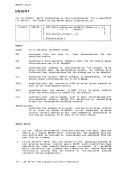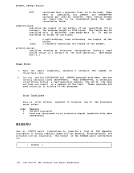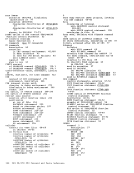DDR
DDRCONTROL STATEMENTS DDR control statements describe the intended processing and the needed I/O devices. I/O definition statements must be specified first. All control statements may be entered from either the console or the
card reader.Only columns 1 to 71 are inspected by the program. All
data after the last operand in a statement is ignored.An output tape
must have theDASD cylinder header records in ascending sequences;
therefore, the extents must be entered in sequence by cylinder.Only one type of function --dump, restore, or copy --may be performed in
one execution, but up to20 statements describing cylinder extents may
be entered.INPUT or OUTPUT statement, or by a null line if the console is used for input. If
additional functions are to be performed, the sequence of control cards
must be repeated. If you do not useINPUT or OUTPUT control statements
to separate the functions you specify when the input is read from a card
reader oreMS file, an error message (DMKDDR702E) is displayed. The
remainder of the input stream will be checked for proper syntax, but no
further DDR operations will be performed.Only those statements needed
to redefine theI/O devices are necessary for subsequent steps. All
otherIIO definition remain the same.
To return toeMS, enter a Dull line (carriage return) in response to
the prompting message (ENTER:). To return directly toCP, key in #CP. The TYPE statements work differently from other DDR control
statements in that they operate on only one data extent at a time. If
the input is from a tape created by the dump function, it must be
positioned at the header record for each step. ThePRINT and TYPE statements have an implied output of either the console (TYPE) or system
printer(PRINT). Therefore, PRINT and TYPE statements need not be
delimitedby an INPUT or OUTPUT statemente IIO DEFINITION STATEMENTS The II) definition statements
devices used while executing
theDASD tape,
DumpDASD, and
Restore
printer
program.
AnINPUT or OUTPUT statement describes each tape and DASD unit used.
The format of theINPUT/OUTPUT statement is:
r----------------------------------------------------------------------,, , r, , I INput I cuu type Ivolserl [(options ••• ) ] , I OUTput I laltapel I I I L J , I I QEiiQn§!: I , I r ,r ,r, , ISKip nn I jMOde 6250 i iREWindl , , IMOde 1600 I , L J lM:Oae 800 I ILEave I 1
L J L J, L-------------------------------------- ________________________________ J Section 2. CMS Commands 47
DDR
card reader.
data after the last operand in a statement is ignored.
must have the
therefore, the extents must be entered in sequence by cylinder.
one execution, but up to
be entered.
additional functions are to be performed, the sequence of control cards
must be repeated. If you do not use
to separate the functions you specify when the input is read from a card
reader or
remainder of the input stream will be checked for proper syntax, but no
further DDR operations will be performed.
to redefine the
other
To return to
the prompting message (ENTER:). To return directly to
statements in that they operate on only one data extent at a time. If
the input is from a tape created by the dump function, it must be
positioned at the header record for each step. The
printer
delimited
devices used while executing
the
Dump
Restore
printer
program.
An
The format of the
r----------------------------------------------------------------------,
L J L J






















































































































































































































































































































































































































